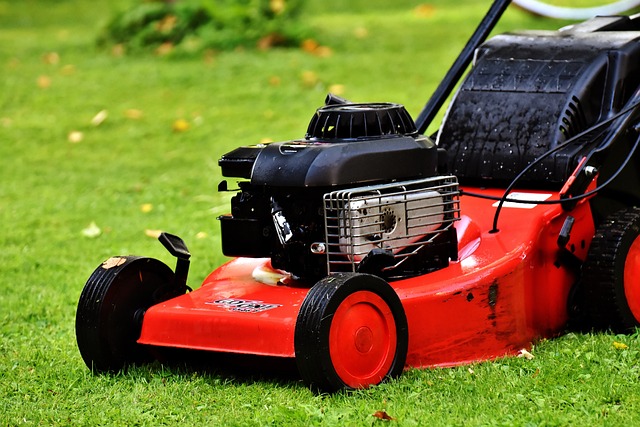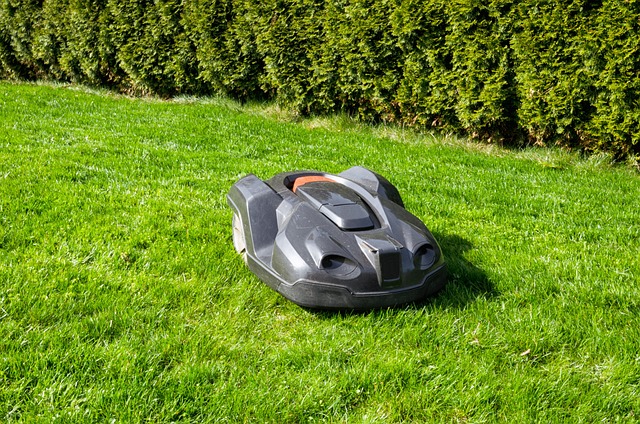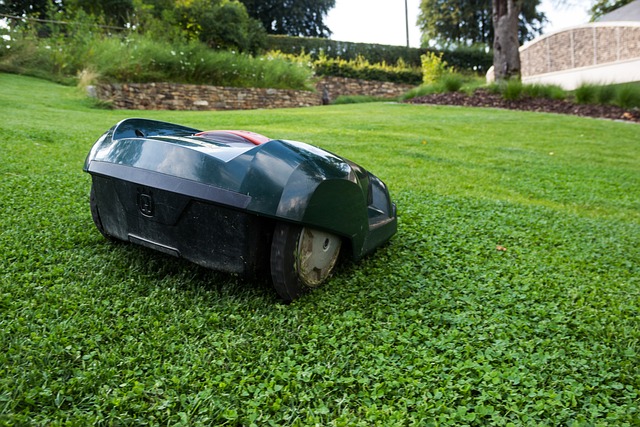Optimizing Your Lawn: Fertilization Strategies, Weed Control, and Organic Landscaping for a Healthy Turf
Effective lawn care and landscaping are essential for maintaining a vibrant, weed-free lawn. A balanced fertilization regimen with the right N-P-K ratio is key for promoting healthy grass growth throughout the year, tailored to whether your gras…….

Effective lawn care and landscaping are essential for maintaining a vibrant, weed-free lawn. A balanced fertilization regimen with the right N-P-K ratio is key for promoting healthy grass growth throughout the year, tailored to whether your grass is cool-season or warm-season. Regular soil testing helps adjust nutrient levels and pH balance, optimizing plant health and resilience. Organic practices are recommended for a sustainable approach, using natural fertilizers and mechanical methods to control weeds without synthetic chemicals. Aeration, overseeding with appropriate cultivars, and employing organic pest management like beneficial insects or neem oil help ensure the lawn's longevity and contribute positively to biodiversity. Integrating these practices into a comprehensive lawn care and landscaping plan not only enhances the aesthetic value of your outdoor space but also supports a healthy ecosystem, showcasing your commitment to sustainable lawn maintenance.
title: “Optimizing Your Lawn’s Health: Fertilization, Weed Control, and Organic Practices for Sustainable Landscapes”
Maintaining a lush, green lawn requires more than occasional mowing; it demands a comprehensive understanding of lawn care and landscaping practices, including fertilization and weed control. This article delves into the essentials of nourishing your turf with the right nutrients, effectively managing weeds, and understanding soil pH balance to foster a healthy lawn environment. We’ll explore strategies to integrate organic methods into your routine, ensuring sustainable landscaping results that are both environmentally friendly and aesthetically pleasing. By mastering these techniques, you can transform your outdoor space into a thriving oasis.
- Understanding the Basics of Lawn Fertilization for a Vibrant Turf
- Strategies for Effective Weed Control in Your Lawn Care Routine
- The Role of Soil Testing and pH Balance in Maintaining a Healthy Lawn
- Integrating Organic Practices into Your Lawn Care and Landscaping Routine for Sustainable Results
Understanding the Basics of Lawn Fertilization for a Vibrant Turf

A well-maintained lawn is a hallmark of meticulous lawn care and landscaping. To cultivate a vibrant turf, understanding the basics of lawn fertilization is paramount. Fertilization is a crucial step in the lawn care and landscaping process, as it provides the necessary nutrients to support grass growth and health. The type of fertilizer used should be selected based on local soil conditions and the specific needs of the grass species present. A balanced N-P-K (Nitrogen, Phosphorus, Potassium) ratio in the fertilizer supports leaf development for a lush green appearance, root growth for strength and resilience, and overall plant health.
Timing is also a key factor in effective lawn fertilization. Most cool-season grasses benefit from fall and early spring applications, while warm-season grasses are best fertilized in late spring and early summer. Soil testing can guide the choice of fertilizer type and the frequency of application, ensuring that nutrients are replenished as they are depleted. In addition to fertilization, a comprehensive lawn care and landscaping routine should include regular mowing at the correct height for the grass type, irrigation to maintain soil moisture, and vigilant weed control to prevent competitive species from outcompeting your turf. By integrating these practices, homeowners can achieve and sustain a thriving lawn that stands as a testament to their dedication to lawn care and landscaping excellence.
Strategies for Effective Weed Control in Your Lawn Care Routine

Maintaining a lush, green lawn requires diligent lawn care and landscaping practices, particularly when it comes to effective weed control. A proactive approach is key; by implementing strategies that target weeds before they become established, you can minimize their impact on your lawn’s health and appearance. One such strategy involves maintaining optimal soil conditions through regular fertilization, which encourages grass growth and crowds out weeds naturally. Choose a balanced fertilizer with the right nitrogen, phosphorus, and potassium ratios to promote robust turfgrass development. Additionally, proper mowing techniques at the correct height for your specific grass type can also play a role in weed suppression by shading the soil surface, reducing weed seed germination, and preventing stress that weeds often exploit.
Another effective measure is the selective application of pre-emergent herbicides, particularly during the spring and fall seasons when most weeds germinate. These herbicides create a barrier in the soil, inhibiting weed seed growth without harming established lawn grasses. Post-emergent herbicides can be used for broadleaf weeds that do slip through, targeting them specifically while leaving your lawn unscathed. Integrating these chemicals responsibly, as part of a broader integrated pest management approach, ensures their efficacy and protects the environment. Regular monitoring of your lawn is essential to identify weed infestations early, allowing for timely intervention and minimizing the need for chemical controls. By combining these strategies with consistent lawn care and landscaping practices, you can maintain a healthy, weed-free lawn that stands up to the challenges of various environmental conditions and pests.
The Role of Soil Testing and pH Balance in Maintaining a Healthy Lawn

Understanding the soil’s composition and pH balance is fundamental in the realm of lawn care and landscaping for maintaining a healthy, thriving lawn. Soil testing is an indispensable practice as it provides valuable insights into the nutrient levels and acidity or alkalinity of the soil. A comprehensive analysis can reveal deficiencies in key nutrients such as nitrogen, phosphorus, and potassium, which are essential for plant growth. Adjusting the pH balance to optimal levels ensures that these nutrients are available to your lawn’s grass in a form it can uptake effectively. A soil pH typically ranging between 5.5 and 7.5 is ideal for most cool-season grasses, while warm-season grasses prefer slightly higher values. Regular soil testing and subsequent pH adjustments help correct any imbalances, fostering the growth of a dense, resilient turf that can better resist weed invasion and disease, which in turn enhances the overall aesthetic appeal of your landscape. Incorporating lime or sulfur as recommended by the test results can modify the pH, creating an environment where your lawn’s root system can flourish. This approach is a cornerstone of effective lawn care and landscaping practices, ensuring that your lawn serves as a verdant, inviting space for years to come.
Integrating Organic Practices into Your Lawn Care and Landscaping Routine for Sustainable Results

Incorporating organic practices into your lawn care and landscaping routine can yield sustainable results that benefit both the environment and the health of your grass. Opting for organic fertilizers, such as composted manure or cottonseed meal, introduces nutrients slowly into the soil, promoting root growth and enhancing the lawn’s resilience without the use of synthetic chemicals. These natural options enrich the soil structure, improving its tilth and water retention capabilities. Additionally, they encourage a diverse microbial population in the soil, which can suppress certain weed species naturally. When it comes to weed control, mechanical methods like hand weeding or using mulches that prevent seed germination can be effective alternatives to herbicides. Mulching not only helps in maintaining soil moisture but also aids in temperature regulation, creating an environment less conducive to many weed types. Furthermore, integrating native plants into your landscaping design can outcompete weeds and provide a more sustainable ecosystem that supports local wildlife. By adopting these organic approaches, you contribute to the health of your lawn and the overall sustainability of your outdoor spaces.
Adopting a holistic approach to lawn care and landscaping organically involves understanding the lifecycle of your grass and weeds. This knowledge allows for timely interventions, such as aerating the lawn to reduce compaction and ensure root growth, and overseeding with cultivars suited to your local climate. Organic pest management strategies, like introducing beneficial insects or using neem oil, can protect against harmful pests without introducing toxic residues into the environment. By being proactive rather than reactive in your lawn care practices, you create a sustainable ecosystem that is resilient to common lawn challenges and contributes positively to biodiversity. Embracing these organic methods not only ensures the longevity of your lawn but also promotes a healthier, more vibrant landscape for years to come.
Lawn Care and Landscaping professionals emphasize that a lush, resilient lawn is a blend of science and art, beginning with a solid understanding of fertilization principles. By incorporating effective weed control measures alongside strategic soil testing and pH balance adjustments, homeowners can maintain a thriving turf that stands as a testament to their commitment to Lawn Care and Landscaping excellence. Organic practices further enhance the health and sustainability of lawns, ensuring they serve as both a beautiful landscape and an environmentally friendly asset. Implementing these integrated approaches not only improves the appearance and function of your yard but also contributes to the broader ecosystem. With careful attention to the nuances of lawn fertilization and weed management, any green space can be transformed into a vibrant oasis that reflects the dedication of Lawn Care and Landscaping practices.







